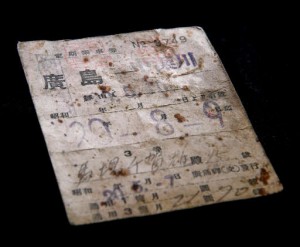Silent Witness: Commuter pass recalls movements of A-bombed survivor
Feb. 6, 2018
by Yuji Yamamoto, Staff Writer
The station names “Hiroshima - Nakafukawa” and the expiration date, “20-8-9” (August 9, 1945), written on the commuter pass, have faded. The pass was in the hand of Chikao Baba, a resident of Asakita Ward, Hiroshima, on the day that the city was attacked with the atomic bomb.
At the time, Mr. Chiba was a first-year student at Hiroshima Prefectural Hiroshima Technical High School. He boarded a train at Nakafukawa Station on the Geibi Line at around 6:30 a.m. and, after getting off the train at Hiroshima Station, he walked to his school in Senda-cho (in today’s Naka Ward), which was located about 2 kilometers from the hypocenter. Because he had drawn a winning number, he was supposed to receive an umbrella, the one and only umbrella rationed to each class.
While he was waiting for his teacher to find the key to the warehouse where the umbrellas were stored, the atomic bomb exploded. Although he was trapped under the school building, he somehow managed to survive. However, 192 of his fellow students, who were helping to demolish buildings near the hypocenter, lost their lives. “If I had not drawn the winning number, and if my teacher had already found the key, I also would have died,” Mr. Chiba said.
The clothes that he had been wearing on August 6 were swept away by the Makurazaki Typhoon of that September. Only the commuter pass, which he had placed between the pages of his textbook, remained. Although he had completely forgotten about the pass, he later found it while putting his house in order in 2015, then decided to donate it to the Peace Memorial Museum.
According to the museum’s Peace Database, five commuter passes, which are assumed to have been used on August 6, are held in its storage room. These have become precious artifacts that can recall the movements of people who experienced the atomic bombing of Hiroshima.
(Originally published on February 6, 2018)
The station names “Hiroshima - Nakafukawa” and the expiration date, “20-8-9” (August 9, 1945), written on the commuter pass, have faded. The pass was in the hand of Chikao Baba, a resident of Asakita Ward, Hiroshima, on the day that the city was attacked with the atomic bomb.
At the time, Mr. Chiba was a first-year student at Hiroshima Prefectural Hiroshima Technical High School. He boarded a train at Nakafukawa Station on the Geibi Line at around 6:30 a.m. and, after getting off the train at Hiroshima Station, he walked to his school in Senda-cho (in today’s Naka Ward), which was located about 2 kilometers from the hypocenter. Because he had drawn a winning number, he was supposed to receive an umbrella, the one and only umbrella rationed to each class.
While he was waiting for his teacher to find the key to the warehouse where the umbrellas were stored, the atomic bomb exploded. Although he was trapped under the school building, he somehow managed to survive. However, 192 of his fellow students, who were helping to demolish buildings near the hypocenter, lost their lives. “If I had not drawn the winning number, and if my teacher had already found the key, I also would have died,” Mr. Chiba said.
The clothes that he had been wearing on August 6 were swept away by the Makurazaki Typhoon of that September. Only the commuter pass, which he had placed between the pages of his textbook, remained. Although he had completely forgotten about the pass, he later found it while putting his house in order in 2015, then decided to donate it to the Peace Memorial Museum.
According to the museum’s Peace Database, five commuter passes, which are assumed to have been used on August 6, are held in its storage room. These have become precious artifacts that can recall the movements of people who experienced the atomic bombing of Hiroshima.
(Originally published on February 6, 2018)








